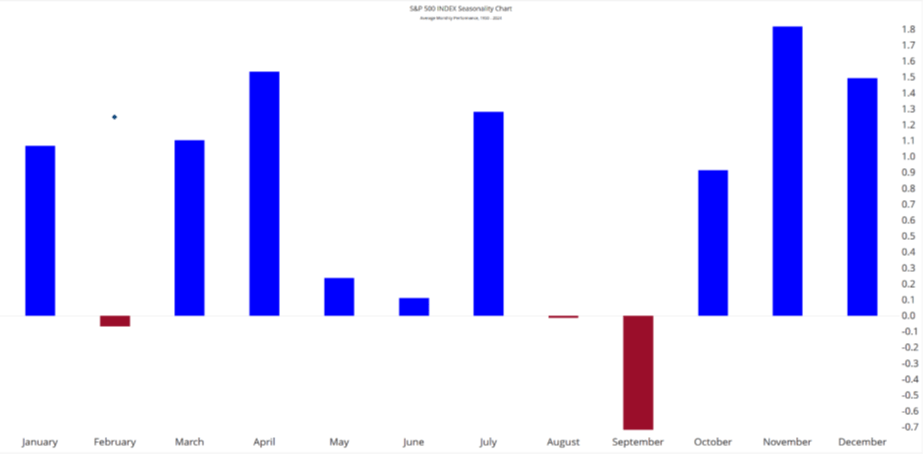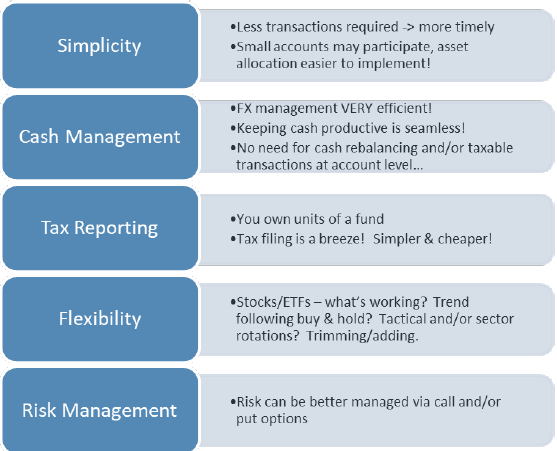Quarterly Strategic Review - 3rd Quarter (Jul-Sep, 2024)
Third Quarter 2024 – October 2024 – It’s That Time of the Year!
More Choppy Market Action, But…
In early August, a mini-crash took place in the markets that was blamed on an unwinding of the Japanese Yen carry trade. In laymen’s terms, a HUGE amount of borrowing has been done in Japan over the years and when the central bank decided, unexpectedly, to raise interest rates by 0.25% (from zero), it caused major gyrations. Stocks were crushed at the open on Monday, August 5th, but we didn’t do much. We didn’t sell or throw away our stocks and that is a very good thing. Why? Because stocks have spent most of the past two months recovering and rising after that selloff.
Despite all the recession fears, and growing concerns about possible volatility associated with the upcoming U.S. election, I have to admit the markets are behaving very well. Seasonally, you might recall that while September is, on average, the weakest month of the calendar year, the period of October through May tends to provide the best returns. This is the most consistent seasonality trend that one can contemplate. Adding to the optimism this year, this new wave of impulsive buying in the emerging markets, and particularly in China, looks potentially important.

Having just travelled in and around Malaysia, Singapore and China, it feels extra-exciting to have been in the southeast Asian region in recent weeks. I was honoured with the recent opportunity to speak at the CIDTAA/IFTA conference in Hainan China and share my investing process. IFTA stands for the International Federation of Technical Analysts. There was much discussion from both academics and some government bureaucrats about what the stimulus measures and headlines were designed to do, and how they’re different than would typically be the case. Having more investment opportunities develop, especially overseas, would be excellent and definitely looks to be of strong potential at this juncture. The Asian stocks have been pulling back for their “first pullback against” the surge in the past week and we’ll be nibbling away in our portfolios to take advantage of what has the potential to be a multi-year, big picture kind of price appreciation.
The Pool!
Yes, finally, it’s coming! There is a lot to do from my end to get the necessary structure and the approvals in place, but we’ll be working hard, as we progress towards a mid/late January 2025 launch for the pooled fund and I am excited!! The inefficiencies related to the structure and management of your accounts (some of which you see, some of which you don’t) are significant, and the pooled structure will allow for much more seamless management of cash, foreign currency and allow for much more exacting and timely decisions to be made from an allocation and sectoral basis. Additional tools that will help with implementation and risk management will also be available.
In a nutshell, everything will appear simpler from your end, and I anticipate much better too! Better for you, our clients, and better from our end, in terms of delivering an optimal and efficient investment strategy and related solution in your accounts. What are some of the key touchpoints?

Aggressive Means Lower Returns and Higher Risk?
When volatility creeps into the market, as a general rule, stocks go down. While we’ve discussed the short-term selling that took place in August, in the more aggressive areas, the early ’24 leaders were hurt. As such, for those of us (that includes me!) that are aggressive in investment approach, it’s been a volatile year. After a huge first quarter, the gains we had amassed were erased entirely, and now, are back on the mend, but not to the same degree as the rest of our clients. Overall, 2024 has been another great year thus far. Sometimes, it’s easier to do less, to own the biggest stocks, the ones that are rising in price, the ones that remain “INsync” with the market and that’s exactly what has happened this year for most of our clients (and most of the dollars in your accounts). Even our most conservative clients have done very well and I remain very pleased with our positioning.
As the S&P 500 sold off earlier this year and the rotation started (from technology and communications) to a broader posture, those sitting with a heavier concentration suffered (as would be expected). But was it a give-up situation? Of course not. But it does mean (and has meant) that those “INvertigo”-type stocks that are supposed to be breaking out and moving higher didn’t help any. Although, as I write this, and the market improves further, they’re starting to behave well again. At one point, I was concerned that 2021 was happening again, where the breakout-type stocks fade away and losses start to compound in our portfolios. But there is a difference between not keeping up with the S&P 500 for a couple of quarters and losing money, and so I concluded that we weren’t faced with similar conditions as 2021, when analyzing our accounts.
Remember I’m speaking short-term; to even refer to a quarter (or year-to-date, for that matter) is short-term-oriented and the reason we’d take higher risk is because we’re pursuing those higher returns. Even if, at times, the effort is greater than the reward experienced, we have to be careful changing risk preferences as the market gyrates. Either way, it’s important to understand that “the pool” will be valuable to ALL clients (in Canada) and it will just come down to the proportion.
What Is “Long-Term Growth?”
When we moved over to Raymond James, we made a drastic change from a more siloed and rigid approach to managing your accounts to one based on managing according to overall risk preference (I refer to “risk buckets”). Our “long-term growth” risk bucket implies a 100% equity benchmark (for Canadian clients, we’d compare ourselves to 50/50 S&P 500 and S&P/TSX Composite) and is able to be represented by a variety of strategies that long-standing clients will understand. The highest proportion is made up of long-term trend following (i.e., “TrendINsync” formerly Equity INtrend), which are the stocks from the #INsyncUniverse, the ones that have outperformed over a 1, 2, 3, 4, 5, and 10-year time frames. At times, we expect to blend in some ETFs and then perhaps, if the market cooperates, a small allocation to “INvertigo”-type breakout stocks (higher growth). Combining the three strategies, which are not highly correlated with one another, allows us to experience a better point on the efficient frontier, with an objective of better returns, with less risk than one strategy alone. This allocation/strategy mix is managed on our side, and part of what will be much more efficient using the pooled structure.
Time For Global Equities?
For the past 14 years running, U.S. equities have dominated the Toronto stock market, making it an opportunity cost for any Canadian that is overexposed to the $TSX. The same can be said for most investors around the world, as the U.S. equity market has been the place to be and, as you know, is full of the biggest, most successful brands and companies, many of whom we all use on a regular basis (i.e., Google, Microsoft, Amazon and so forth).
The rest of the world, including both the emerging markets and the Toronto stock market, tend to be more “value” oriented, and benefit when value stocks are outperforming growth stocks. To be clear, this is NOT happening right now. That said, there are changes happening in global markets and some of them are starting to emerge as more consistent winners. Some of you have exposure to Argentina via Global X Argentina ($ARGT) and Banco Marco ($BMA), an Argentinian bank. The recent buying in China has led to some new positions in stocks like LI Auto ($LI), Alibaba ($BABA), Qifu Technology ($QFIN) and Coupang ($CPNG), a Korean online retailer, which has been a winner too, for some time. We’ve also started to see currencies in Asia rise vis-à-vis the U.S. dollar, and some initial investments in iShares Malaysia ($EWM) and SPDR S&P Emerging Asia Pacific ($GMF) have been made.
Will it keep developing? Only time will tell, but as usual, we’ll only expose ourselves to such opportunities if they’re paying off and will still manage risk without question.
Our Strategy and Positioning
Given the very healthy (surprising to many!) 70%+ stocks greater than the 200-day moving average in the S&P 500, and the fact that we’re moving into the most seasonally positive time of the year, we will continue to maintain strong equity positions. Gold continues to work very well, and silver, in the bigger picture, continues to develop, as we discussed last quarter. Consolidations are healthy, and provide and create the fuel, for further price advances. The top performing assets in 2024 aren’t stocks, but instead remain Bitcoin, gold and silver, and most of our clients have exposure to all of them. With such limited correlations, relative strength from non-equities like those “alternatives” mentioned and bigger picture uptrends in place, we’ll continue to hold such assets into the future.
I just updated the INsync Universe and there are 122 stocks that met the rigid screen and, despite the gyrations in the market, widely-held stocks like Intact Financial ($IFC:TSX), Broadcom ($AVGO), Berkshire Hathaway ($BRK.B), Vertex Pharmaceuticals ($VRTX), Ely Lily ($LLY) and Cintas ($CTAS) continue to do what they’re supposed to do. Rise in long-term uptrends. As Isaac Newton once postulated, a trend in motion tends to stay in motion, until acted upon by an outside force. When that force arrives, we’ll take our profits as necessary, as the trends end. Until then, let’s remain optimistic as we move through the remainder of 2024.
Sincerely,
David Cox, CFA, CMT, FMA, FCSI, BMath
Senior Portfolio Manager, Wealth Advisor
Raymond James Ltd.
Phone: 519.883.6031
Unit 1 – 595 Parkside Drive | Waterloo, ON | N2L 0C7
david.cox@raymondjames.ca
www.financiallyinsync.com
![]() @DavidCoxRJ
@DavidCoxRJ
Disclaimer: Information in this article is from sources believed to be reliable, however, we cannot represent that it is accurate or complete. It is provided as a general source of information and should not be considered personal investment advice or solicitation to buy or sell securities. The views are those of the author, Financially INsync Team, and not necessarily those of Raymond James Ltd. Investors considering any investment should consult with their Investment Advisor to ensure that it is suitable for the investor’s circumstances and risk tolerance before making any investment decision. Statistics, factual data and other information are from sources believed to be reliable but accuracy cannot be guaranteed. It is furnished on the basis and understanding that Raymond James Ltd. is to be under no liability whatsoever in respect thereof. It is for information purposes only and is not to be construed as an offer or solicitation for the sale or purchase of securities.
Raymond James Ltd. is a Member Canadian Investor Protection Fund.
Raymond James (USA) Ltd. (RJLU) advisors may only conduct business with residents of the states and/or jurisdictions for which they are properly registered. Raymond James (USA) Ltd., member FINRA/SIPC.
